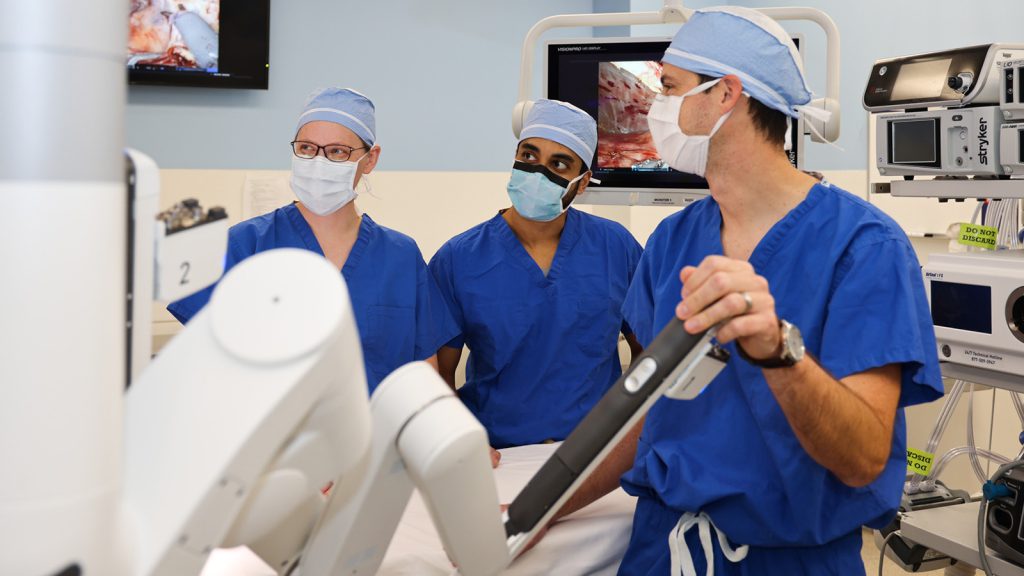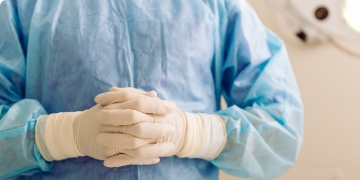
Inguinal Hernias
An inguinal hernia happens when the contents of the abdomen bulge through a weak spot in the lower abdominal wall near the groin.
Inguinal hernias are named for the inguinal canals, which are passages through the lower abdominal wall on either side of your groin.
The abdominal wall is the muscle that covers your stomach, intestines and other organs in your abdomen. Layers of tissue, fat and skin also make up the abdominal wall.
Inguinal hernias usually contain intestines or fat that bulge from the inside of your abdomen through the groin area. This intestine or fat may slide in and out of the inguinal hernia (the weak area of the abdominal wall), and a doctor might be able to push the hernia contents back inside the abdomen. Inguinal hernias are more common on the right side of the groin, though they can happen on the right or left side.
A hernia can also happen in lower passages in the groin called femoral canals. This type of hernia is also known as a femoral hernia.
How common are inguinal hernias?
Inguinal hernias are a common medical problem. Some people are more likely to have an inguinal hernia than others.
Adult males are far more likely to have inguinal hernias than female adults. For adults, the chance of having an inguinal hernia increases with age. For children, most inguinal hernias happen between the ages of 0 and 5 years.
People who have had their prostate removed (called prostatectomy) are more likely to have inguinal hernias. Family history of inguinal hernias and certain connective tissue disorders are also common risk factors.
Inguinal Hernia Types and Causes
There are two types of inguinal hernias: indirect and direct. The two types have different causes. Indirect inguinal hernias usually happen in newborns and children, but they can also present at any time in life. Direct inguinal hernias are most common among adult males.
Indirect Inguinal Hernia Causes
Indirect inguinal hernias are caused by a congenital defect in the abdominal wall. In a developing fetus, there are openings inside the inguinal canals. These openings usually close before birth. For some newborns, one or both of the openings remain open. Contents of the abdomen may bulge through this opening, causing an inguinal hernia. The hernia can happen in a newborn or even years later.
Direct Inguinal Hernia Causes
Direct inguinal hernias are caused by weak spots in the inguinal canal that were not present at birth. Contents of the abdomen, including parts of tissues or organs, may bulge out through this weak area and be visible through the skin. Causes of direct inguinal hernias can include:
- Connective tissue disorders or weak connective tissue
- Certain genes that increase inguinal hernia risk
- Straining or pressure inside the abdomen
- Chronic cough
- Chronic constipation
- Heavy lifting, standing or walking for several hours
- Other repeated activities that increase pressure inside the abdomen

Inguinal Hernia Symptoms
The main symptom of an inguinal hernia is a bulge in the groin area between the lower abdomen and thighs. In males, the bulge may be in the scrotum (the sac containing the testicles).
A small bulge may slide back and forth through the opening in the abdominal wall. The hernia bulge might disappear when you lie down and get bigger when you strain. A doctor may be able to push a larger hernia back inside the abdomen.
Inguinal hernia symptoms also include:
- Pain in the groin or scrotum
- Discomfort, heaviness, aching, burning or pressure in the groin or scrotum
- Increased pain and discomfort when lifting, straining, coughing or standing.
If the symptoms of an inguinal hernia get worse, it could be a sign of serious complications requiring immediate medical attention.
What are the complications of inguinal hernias?
An inguinal hernia can become stuck (also called incarcerated), meaning the contents of the bulge cannot be massaged back inside the abdomen. This can lead to serious complications.
If the hernia contents are stuck outside the abdominal wall, it may become strangulated. A strangulated hernia happens when blood flow to the herniated contents (such as the intestines) is cut off. Without blood flow, the tissues or parts of organs inside the hernia can die.
If a hernia is stuck or strangulated, this can cause intestinal obstruction and death of the strangulated intestine. This may require emergency surgery.
Strangulated hernia symptoms:
- A hernia bulge that is larger than before
- A hernia bulge that does not push back inside the abdomen
- Fever
- Redness of the skin in the area of the hernia
- Sudden or severe groin pain
- Symptoms of intestinal obstruction, including abdominal pain, bloating, nausea and vomiting
Inguinal Hernia Testing and Diagnosis
To diagnose an inguinal hernia, your doctor will ask about your medical history and symptoms, perform a physical examination, and in some cases order other tests.
During a physical exam, your doctor will look and feel for a bulge in your groin area. The doctor may ask you to stand and cough.
In some cases, your doctor may order imaging tests to help diagnose an inguinal hernia. Imaging tests can also help check for complications. These tests include:
- Ultrasound: a kind of test that uses sound waves to create an image of the hernia and your organs
- CT scan: a kind of test that uses a combination of x-rays and computer technology to create images
- MRI: a kind of test that takes pictures of your organs and tissues without using x-rays
Inguinal Hernia Treatment
Most people with inguinal hernias will need surgery. A hernia will not go away on its own, and there are no nonsurgical options that will fix or repair a hernia.
Non-surgical observation (also called “watchful waiting”) may be an option for some people with mild symptoms related to their hernia.
There are different types of hernia repair surgery, including open and minimally invasive approaches. Which type of surgery is best for you depends on your hernia, surgical history, overall health and other factors. If your doctor recommends surgery, they will discuss your surgical options and help you decide on the treatment that’s right for you.
Open Hernia Surgery
In open hernia repair surgery, the surgeon makes a cut in the lower abdomen or groin to view and repair the hernia. The bulging tissue is gently put back inside the abdomen. After surgery, the surgeon typically uses stitches and mesh to repair the hernia and close the abdominal wall muscles.

Minimally Invasive Hernia Surgery
Minimally invasive hernia repair surgery uses smaller incisions than traditional open surgery. There are two types of minimally invasive surgery: laparoscopic and robotic surgery.
In laparoscopic surgery, the surgeon makes small cuts (each less than a quarter inch long) in the lower abdomen or groin. Small surgical tools go through these incisions to help the surgeon view and repair the hernia. The surgeon uses a thin scope with a camera to see the hernia during surgery. The bulging tissue is gently put back inside the abdomen using small surgical tools.
In robotic surgery, the surgeon uses a robot with special surgical tools to assist in the procedure. The surgeon starts by making small cuts (each less than a quarter inch long) in the lower abdomen or groin. Then, surgical tools attached to the robot go through these incisions. The surgeon sits at a console in the operating room and uses handheld controls to move the tools and perform surgery.
After any type of hernia repair surgery, the surgeon typically uses stitches and mesh to repair the hernia and close the abdominal wall. Synthetic, or permanent, mesh strengthens the closure to prevent the hernia from bulging back out. Your surgeon will discuss the use of mesh with you during your visit.
Watchful Waiting
If an inguinal hernia causes mild or no symptoms, your doctor may recommend against surgery, in favor of observing the hernia, which is also called watchful waiting. This means delaying surgery and monitoring the hernia to notice any changes in symptoms or severity. It is important to see a doctor for an inguinal hernia. Your doctor can help you determine if watchful waiting would be safe for your hernia.
Usually, symptoms of an inguinal hernia will get worse with time. Watchful waiting can delay surgery, but eventual surgical treatment is the only way to fix an inguinal hernia.
What should I expect before and after hernia surgery?
Hernia repair surgery is the only way to fix a hernia and prevent it from coming back. There are steps you and your hernia care team can take before and after surgery to help you have a successful outcome.
Before Surgery
Your Washington University hernia surgeon will begin by asking about your medical history and symptoms, as well as your goals for life after surgery. This will help determine the best treatment option for your hernia.
Talking to your surgeon about your goals is an important step in deciding on treatment. Your surgeon will ask you what kinds of activities you want to return to after surgery. You and your doctor will also go over any other health conditions you have.
Before having hernia surgery, your doctor will make sure you are healthy enough for surgery. Maintaining a healthy weight and stopping smoking if you smoke can both improve your recovery after surgery. Being overweight or obese can increase the risk of recurrence (the hernia coming back after surgery). Smoking can cause complications with wound healing after surgery. Your hernia care team can help you find resources if there is anything you need to do to prepare for surgery.
General anesthesia is used in all minimally invasive inguinal hernia surgeries. An open hernia repair may occasionally be done under local anesthesia with conscious sedation, avoiding general anesthesia.
After Surgery
After surgery, you may have some pain or discomfort. The pain is usually mild and goes away within about 2 weeks after surgery.
Minimally invasive (laparoscopic and robotic) surgery uses smaller incisions than traditional open surgery. These techniques typically result in less pain and faster recovery times.
After hernia surgery, many patients can go home the same day. Some people may need to stay in the hospital overnight.
Your doctor will recommend when you can safely return to your usual activities. Most people are able to return to daily activities within about 3 to 5 days after surgery. You may not be able to do any strenuous activity for about 4 to 6 weeks following inguinal hernia surgery. In some complex cases, lifting and activity restrictions may last longer.
Prevention
Indirect inguinal hernias are caused by a birth defect you are born with. There is no way to prevent indirect inguinal hernias.
Direct inguinal hernias may be prevented by learning how to safely lift heavy objects, treating constipation to prevent straining during bowel movements, treating persistent or chronic coughs, treating any difficulty with urination, and losing weight if you are overweight or obese.
Washington University Hernia Surgery
Washington University hernia surgeons provide personalized care for people with hernias. Our surgeons are specialists in minimally invasive abdominal wall reconstruction using laparoscopic and robotic surgery. Every hernia is different, so we tailor our approach for your best outcome. We are here to help you get back to your regular daily activities without the pain of a bulging hernia.


